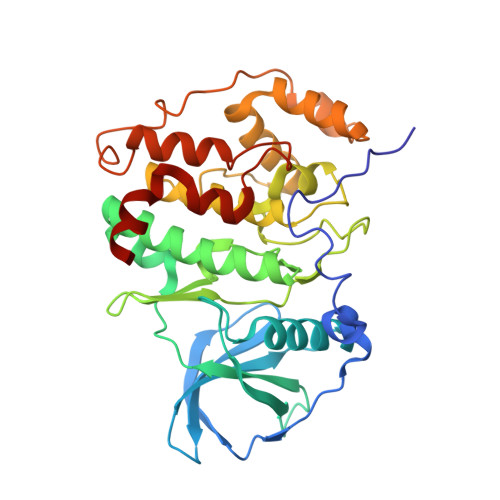Low-density crystal packing of human protein kinase CK2 catalytic subunit in complex with resorufin or other ligands: a tool to study the unique hinge-region plasticity of the enzyme without packing bias.
Klopffleisch, K., Issinger, O.G., Niefind, K.(2012) Acta Crystallogr D Biol Crystallogr 68: 883-892
- PubMed: 22868753
- DOI: https://doi.org/10.1107/S0907444912016587
- Primary Citation of Related Structures:
3U87, 3U9C - PubMed Abstract:
A low-resolution structure of the catalytic subunit CK2¦Á of human protein kinase CK2 (formerly known as casein kinase 2) in complex with the ATP-competitive inhibitor resorufin is presented. The structure supplements previous human CK2¦Á structures in which the interdomain hinge/helix ¦ÁD region adopts a closed conformation correlating to a canonically established catalytic spine as is typical for eukaryotic protein kinases. In the corresponding crystal packing the hinge/helix ¦ÁD region is nearly unaffected by crystal contacts, so that largely unbiased conformational adaptions are possible. This is documented by published human CK2¦Á structures with the same crystal packing but with an open hinge/helix ¦ÁD region, one of which has been redetermined here with a higher symmetry. An overview of all published human CK2¦Á crystal packings serves as the basis for a discussion of the factors that determine whether the open or the closed hinge/helix ¦ÁD conformation is adopted. Lyotropic salts in crystallization support the closed conformation, in which the Phe121 side chain complements the hydrophobic catalytic spine ensemble. Consequently, genuine ligand effects on the hinge/helix ¦ÁD conformation can be best studied under moderate salt conditions. Ligands that stabilize either the open or the closed conformation by hydrogen bonds are known, but a general rule is not yet apparent.
Organizational Affiliation:
Department f¨¹r Chemie, Institut f¨¹r Biochemie, Universit?t zu K?ln, Otto-Fischer-Strasse 12-14, D-50674 K?ln, Germany.




















